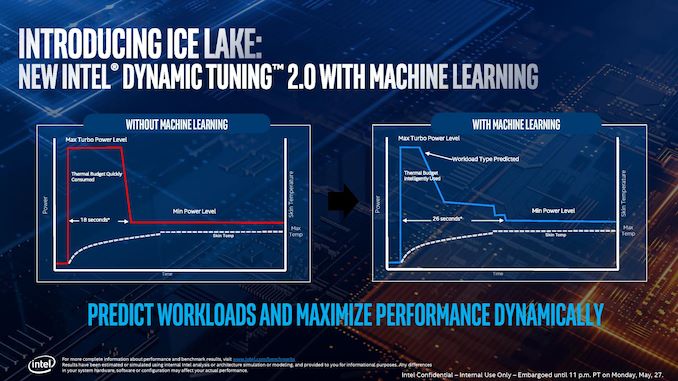Examining Intel's Ice Lake Processors: Taking a Bite of the Sunny Cove Microarchitecture
by Dr. Ian Cutress on July 30, 2019 9:30 AM EST- Posted in
- CPUs
- Intel
- 10nm
- Microarchitecture
- Ice Lake
- Project Athena
- Sunny Cove
- Gen11
Using Power More Efficiently: Dynamic Tuning 2.0
A common thread in modern microprocessor design is being able to use the power budget available. There have been many articles devoted to how to define power budgets, thermal budgets, and what the mysterious ‘TDP’ (thermal design power) actually means in relation to power consumption. Intel broadly uses TDP and power consumption simultaneously, along with a few other values, such as power limits 1 and 2 (PL1 and PL2), which apply to sustained power draw and peak power draw respectively. Most Intel processors up until this point will allow a processor to turbo, up to a peak power draw of PL2 for a fixed time, before enforcing a PL1 sustained power draw. This is all very OEM dependent as well. However, for Ice Lake, this changes a bit.
For Ice Lake, Intel has a new feature called Dynamic Tuning 2.0, which implements a layer of machine learning on top of the standard turbo mode. The idea behind DT2.0 is that the processor can predict the type of workload that is incoming, say transcode, and adjust the power budget intelligently to give a longer turbo experience.
Technically the concepts of PL1 and PL2 don’t magically disappear under this new regime – the processor ends up going below max turbo because the algorithm predicts that the user won’t need it, and this saves up ‘power budget’ in order to enable the turbo to work for longer.
This is a topic that Intel will hopefully go into more detail. We do know that it requires collaboration at the OS level, but how these algorithms are trained would be a useful trove of information. It is unclear whether Intel will allow this feature to be enabled/disabled at the user level, for testing purposes, but it should be noted that unless it is by default ‘on’ for OEM systems, we might end up with some systems enabling it while others do not.











107 Comments
View All Comments
s.yu - Thursday, August 1, 2019 - link
"Charge 4+hrs in 30 mins"...Ok, I think "4+hrs battery life under 30 min. charging" sounds better, or just Intel's version.
29a - Thursday, August 1, 2019 - link
Should Intel go ahead with the naming scheme, it is going to offer a cluster of mixed messages.I believe the word you are looking for there is clusterfuck.
ifThenError - Friday, August 2, 2019 - link
To bad the article doesn't state any further details about the HEVC encoders. Would be interesting to hear if Intel only improved the speed or if they also worked on compression and quality.I bought a Gemini Lake system last year to try the encoding in hardware and have very mixed feelings about Intel's Quick Sync since. The encoding speed is impressive with the last generation already, and all the while CPU and GPU are practically in idle. On the downside the image quality and compression ratio is highly underwhelming and not even near usable for “content creation“ or mere transcoding. It suffices for video calls at best. Even encoding h264 in software reaches far better compression efficiency while being not much slower on a low end CPU.
IIRC Intel promised some “quality mode” for their upcoming encoders, but I can't remember if that was for the gen11 graphics.
intel_gene - Friday, August 2, 2019 - link
There is some information on GNA available. It is accessed through Intel's OpenVINO.https://docs.openvinotoolkit.org/latest/_docs_IE_D...
https://github.com/opencv/dldt/tree/2019/inference...
There is some background information here:
https://sigport.org/sites/default/files/docs/Poste...
urbanman2004 - Friday, August 2, 2019 - link
I wonder what happens to Project Athena if none of the products released by the vendor partners/OEMs meet the criteria that Intel's established.GreenReaper - Saturday, August 3, 2019 - link
Plagues of snakes, owls, eagles, Asari, etc.gambita - Monday, August 5, 2019 - link
nice of you to do intels bidding and promote and help their prhowtomakedeliciousfood - Thursday, August 8, 2019 - link
www.howtomakedeliciousfood.comHikariWS - Sunday, August 11, 2019 - link
These improvements on serial performance are great, it's awesome to have bigger buffers and more execution units. But in clock area it seems to be a big drawback.I'm sure clock issues is the reason we won't have any Ice Lake on desktop, and Comet Lake on laptops on the same generation. But, why no 6C Ice Lake? This opened a but alert sign on me.
But what also called my attention is its IGP power. Most mid range and above laptops ae using nVidia GPU. That's sad for us who want performance and won't play on it, because mid laptops are alrdy all coming with nVidia GPU which makes them more expensive.
Now I hope to have these segments using Intel IGP and not have nVidia GPU anymore. Good to us on having less money wasted on hardware we don't need, bad for nVidia.
nils_ - Wednesday, August 14, 2019 - link
Can you please stop eating the chips? Yield must be bad enough as it is!